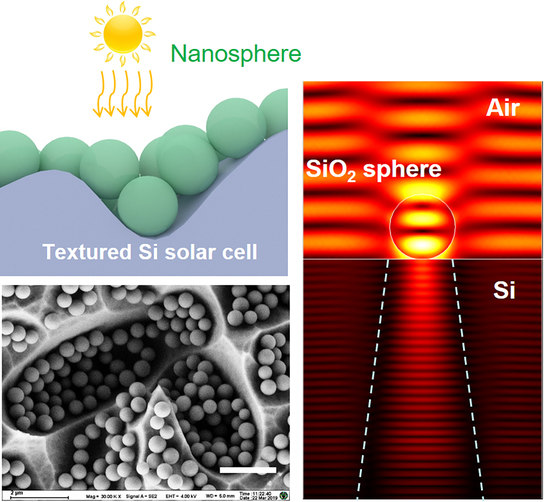Simple Self-Assembly Strategy of Nanospheres on 3D Substrate and Its Application for Enhanced Textured Silicon Solar Cell
Abstract
:1. Introduction
2. Materials and Methods
2.1. Materials
2.2. Synthesis of SiO2 Nanosphere
2.3. Self-Assembly Process of SiO2 Nanosphere
2.4. Characterization of Textured Silicon Solar Cells
2.5. Modeling of Silicon Solar Cell with SiO2 Nanospheres
3. Results and Discussion
3.1. Self-Assembled SiO2 Nanocoating on Planar and Textured 3D Substrates
3.2. The Performance Analysis of Textured Si Solar Cells with SiO2 Nanosphere Coatings
3.3. The Influence of Poly-l-Lysine on the Performance of Solar Cells
3.4. Optical Analysis of Textured Si Solar Cells with SiO2 Nanosphere Coatings
4. Conclusions
Supplementary Materials
Author Contributions
Funding
Data Availability Statement
Acknowledgments
Conflicts of Interest
References
- Garnett, E.C.; Ehrler, B.; Polman, A.; Alarcon-Llado, E. Photonics for Photovoltaics: Advances and Opportunities. ACS Photonics 2021, 8, 61–70. [Google Scholar] [CrossRef] [PubMed]
- Oliveira, R.; Mouquinho, A.; Centeno, P.; Alexandre, M.; Haque, S.; Martins, R.; Fortunato, E.; Águas, H.; Mendes, M. Colloidal Lithography for Photovoltaics: An Attractive Route for Light Management. Nanomaterials 2021, 11, 1665. [Google Scholar] [CrossRef] [PubMed]
- Wu, J.-Y.; Chun, Y.T.; Li, S.; Zhang, T.; Wang, J.; Shrestha, P.K.; Chu, D. Broadband MoS2 Field-Effect Phototransistors: Ultrasensitive Visible-Light Photoresponse and Negative Infrared Photoresponse. Adv. Mater. 2018, 30, 1705880. [Google Scholar] [CrossRef] [PubMed]
- Zhang, T.; Su, D.; Li, R.-Z.; Wang, S.-J.; Shan, F.; Xu, J.-J.; Zhang, X.-Y. Plasmonic nanostructures for electronic designs of photovoltaic devices: Plasmonic hot-carrier photovoltaic architectures and plasmonic electrode structures. J. Photonics Energy 2016, 6, 042504. [Google Scholar] [CrossRef]
- Wang, L.; Liu, F.; Zhao, B.; Ning, Y.; Zhang, L.; Bradley, R.; Wu, W. Carbon Nanobowls Filled with MoS2 Nanosheets as Electrode Materials for Supercapacitors. ACS Appl. Nano Mater. 2020, 3, 6448–6459. [Google Scholar] [CrossRef]
- Choi, Y.J.; Pyun, S.B.; Cho, E.C. Slippery Colloidal Crystal Monolayers for Sustainable Enhancement of Commercial Solar Cell Performance. ACS Appl. Energy Mater. 2021, 4, 303–311. [Google Scholar] [CrossRef]
- Hou, Y.; Wang, Z.; Cai, C.; Hao, X.; Li, N.; Zhao, N.; Zhao, Y.; Chen, L.; Ma, H.; Xu, J. Conformal Nanocoatings with Uniform and Controllable Thickness on Microstructured Surfaces: A General Assembly Route. Adv. Mater. 2018, 30, 1704131. [Google Scholar] [CrossRef]
- Montelongo, Y.; Sikdar, D.; Ma, Y.; McIntosh, A.J.S.; Velleman, L.; Kucernak, A.R.; Edel, J.B.; Kornyshev, A.A. Electrotunable nanoplasmonic liquid mirror. Nat. Mater. 2017, 16, 1127–1135. [Google Scholar] [CrossRef]
- Li, S.; Xu, Q.; Zhou, Z.; Zhao, W.; Li, X.; Wen, Z.; Yao, Y.; Xu, H.; Deng, H.; Dai, N.; et al. Flexible Transparent Heat Mirror for Thermal Applications. Nanomaterials 2020, 10, 2479. [Google Scholar] [CrossRef]
- Wang, B.; Leu, P.W. High index of refraction nanosphere coatings for light trapping in crystalline silicon thin film solar cells. Nano Energy 2015, 13, 226–232. [Google Scholar] [CrossRef]
- Li, R.-Z.; Peng, R.; Kihm, K.D.; Bai, S.; Bridges, D.; Tumuluri, U.; Wu, Z.; Zhang, T.; Compagnini, G.; Feng, Z.; et al. High-rate in-plane micro-supercapacitors scribed onto photo paper using in situ femtolaser-reduced graphene oxide/Au nanoparticle microelectrodes. Energy Environ. Sci. 2016, 9, 1458–1467. [Google Scholar] [CrossRef]
- Li, R.-Z.; Hu, A.; Bridges, D.; Zhang, T.; Oakes, K.D.; Peng, R.; Tumuluri, U.; Wu, Z.; Feng, Z. Robust Ag nanoplate ink for flexible electronics packaging. Nanoscale 2015, 7, 7368–7377. [Google Scholar] [CrossRef]
- Zhang, T.; Iqbal, S.; Zhang, X.-Y.; Wu, W.; Su, D.; Zhou, H.-L. Recent advances in highly efficient organic-silicon hybrid solar cells. Sol. Energy Mater. Sol. Cells 2020, 204, 110245. [Google Scholar] [CrossRef]
- Hao, J.; Hao, H.; Li, J.; Shi, L.; Zhong, T.; Zhang, C.; Dong, J.; Xing, J.; Liu, H.; Zhang, Z. Light Trapping Effect in Perovskite Solar Cells by the Addition of Ag Nanoparticles, Using Textured Substrates. Nanomaterials 2018, 8, 815. [Google Scholar] [CrossRef] [Green Version]
- Tennyson, E.M.; Doherty, T.A.S.; Stranks, S.D. Heterogeneity at multiple length scales in halide perovskite semiconductors. Nat. Rev. Mater. 2019, 4, 573–587. [Google Scholar] [CrossRef]
- Tennyson, E.M.; Howard, J.M.; Leite, M.S. Mesoscale Functional Imaging of Materials for Photovoltaics. ACS Energy Lett. 2017, 2, 1825–1834. [Google Scholar] [CrossRef]
- Su, D.; Zhao, N.; Wang, S.J.; Zhou, H.L.; Yang, Y.; Xiong, M.; Zhang, T. Lysine Assisted Self-assembly of Silica Micro-spheres on Textured Polycrystalline Silicon Solar Cells for Light Trapping. In Proceedings of the 2019 PhotonIcs & Electromagnetics Research Symposium—Spring (PIERS-Spring), Rome, Italy, 17–20 June 2019; pp. 1252–1257. [Google Scholar]
- Grzelczak, M.; Vermant, J.; Furst, E.; Liz-Marzán, L.M. Directed Self-Assembly of Nanoparticles. ACS Nano 2010, 4, 3591–3605. [Google Scholar] [CrossRef] [PubMed]
- Lu, X.; Huang, Y.; Liu, B.; Zhang, L.; Song, L.; Zhang, J.; Zhang, A.; Chen, T. Light-Controlled Shrinkage of Large-Area Gold Nanoparticle Monolayer Film for Tunable SERS Activity. Chem. Mater. 2018, 30, 1989–1997. [Google Scholar] [CrossRef]
- Salih, A.E.; Elsherif, M.; Alam, F.; Yetisen, A.K.; Butt, H. Gold Nanocomposite Contact Lenses for Color Blindness Management. ACS Nano 2021, 15, 4870–4880. [Google Scholar] [CrossRef]
- Shin, Y.; Song, J.; Kim, D.; Kang, T. Facile Preparation of Ultrasmall Void Metallic Nanogap from Self-Assembled Gold-Silica Core-Shell Nanoparticles Monolayer via Kinetic Control. Adv. Mater. 2015, 27, 4344–4350. [Google Scholar] [CrossRef]
- Zhang, X.-Y.; Hu, A.; Zhang, T.; Lei, W.; Xue, X.-J.; Zhou, Y.; Duley, W.W. Self-Assembly of Large-Scale and Ultrathin Silver Nanoplate Films with Tunable Plasmon Resonance Properties. ACS Nano 2011, 5, 9082–9092. [Google Scholar] [CrossRef]
- Zhang, X.-Y.; Shan, F.; Zhou, H.-L.; Su, D.; Xue, X.-M.; Wu, J.-Y.; Chen, Y.-Z.; Zhao, N.; Zhang, T. Silver nanoplate aggregation based multifunctional black metal absorbers for localization, photothermic harnessing enhancement and omnidirectional light antireflection. J. Mater. Chem. C 2017, 6, 989–999. [Google Scholar] [CrossRef]
- Cai, H.; Meng, Q.; Ding, H.; Zhang, K.; Lin, Y.; Ren, W.; Yu, X.; Wu, Y.; Zhang, G.; Li, M.; et al. Utilization of Resist Stencil Lithography for Multidimensional Fabrication on a Curved Surface. ACS Nano 2018, 12, 9626–9632. [Google Scholar] [CrossRef] [PubMed]
- Gao, J.; Pei, K.; Sun, T.; Wang, Y.; Zhang, L.; Peng, W.; Lin, Q.; Giersig, M.; Kempa, K.; Ren, Z.; et al. Transparent Nanowire Network Electrode for Textured Semiconductors. Small 2012, 9, 733–737. [Google Scholar] [CrossRef] [PubMed]
- Niesen, B.; Blondiaux, N.; Boccard, M.; Stuckelberger, M.; Pugin, R.; Scolan, E.; Meillaud, F.; Haug, F.-J.; Hessler-Wyser, A.; Ballif, C. Self-Patterned Nanoparticle Layers for Vertical Interconnects: Application in Tandem Solar Cells. Nano Lett. 2014, 14, 5085–5091. [Google Scholar] [CrossRef]
- Wu, M.; Ma, B.; Pan, T.; Chen, S.; Sun, J. Silver-Nanoparticle-Colored Cotton Fabrics with Tunable Colors and Durable Antibacterial and Self-Healing Superhydrophobic Properties. Adv. Funct. Mater. 2016, 26, 569–576. [Google Scholar] [CrossRef]
- Grandidier, J.; Callahan, D.M.; Munday, J.N.; Atwater, H.A. Light Absorption Enhancement in Thin-Film Solar Cells Using Whispering Gallery Modes in Dielectric Nanospheres. Adv. Mater. 2011, 23, 1272–1276. [Google Scholar] [CrossRef]
- Ha, D.; Gong, C.; Leite, M.; Munday, J.N. Demonstration of Resonance Coupling in Scalable Dielectric Microresonator Coatings for Photovoltaics. ACS Appl. Mater. Interfaces 2016, 8, 24536–24542. [Google Scholar] [CrossRef]
- Ha, D.; Yoon, Y.; Zhitenev, N.B. Nanoscale imaging of photocurrent enhancement by resonator array photovoltaic coatings. Nanotechnology 2018, 29, 145401. [Google Scholar] [CrossRef]
- Zhang, Y.; Chen, S.; Hu, D.; Xu, Y.; Wang, S.; Qin, F.; Cao, Y.; Guan, B.-O.; Miroshnichenko, A.; Gu, M.; et al. Coloring solar cells with simultaneously high efficiency by low-index dielectric nanoparticles. Nano Energy 2019, 62, 682–690. [Google Scholar] [CrossRef]
- Esmaeilzad, N.S.; Demir, A.K.; Hajivandi, J.; Ciftpinar, H.; Turan, R.; Kurt, H.; Bek, A. Nanosphere Concentrated Photovoltaics with Shape Control. Adv. Opt. Mater. 2021, 9, 2000943. [Google Scholar] [CrossRef]
- Dabirian, A.; Byranvand, M.M.; Naqavi, A.; Kharat, A.N.; Taghavinia, N. Self-Assembled Monolayer of Wavelength-Scale Core–Shell Particles for Low-Loss Plasmonic and Broadband Light Trapping in Solar Cells. ACS Appl. Mater. Interfaces 2016, 8, 247–255. [Google Scholar] [CrossRef] [PubMed]
- Jiang, Y.; Liu, C.; Wang, X.; Wang, T.; Jiang, J. Fluorescent Phthalocyanine Assembly Distinguishes Chiral Isomers of Different Types of Amino Acids and Sugars. Langmuir 2017, 33, 7239–7247. [Google Scholar] [CrossRef] [PubMed]
- Li, W.-C.; Lee, S.-W. The characteristics of lysine-mediated self-assembly of gold nanoparticles on the ITO glass. Curr. Appl. Phys. 2012, 12, 1361–1365. [Google Scholar] [CrossRef]
- Hartman, R.; Schwaner, R.C.; Hermans, J. Beta poly(l-lysine): A model system for biological self-assembly. J. Mol. Biol. 1974, 90, 415–429. [Google Scholar] [CrossRef]
- Wu, S.-H.; Mou, C.-Y.; Lin, H.-P. Synthesis of mesoporous silica nanoparticles. Chem. Soc. Rev. 2013, 42, 3862–3875. [Google Scholar] [CrossRef] [PubMed]
- Palik, E.D. Preface. In Handbook of Optical Constants of Solids; Palik, E.D., Ed.; Academic Press: Cambridge, MA, USA, 1985. [Google Scholar]
- Huwiler, C.; Kunzler, T.P.; Textor, M.; Vörös, J.; Spencer, N.D. Functionalizable Nanomorphology Gradients via Colloidal Self-Assembly. Langmuir 2007, 23, 5929–5935. [Google Scholar] [CrossRef]
- Zhu, S.-Q.; Zhang, T.; Guo, X.-L.; Zhang, X.-Y. Self-assembly of large-scale gold nanoparticle arrays and their application in SERS. Nanoscale Res. Lett. 2014, 9, 114. [Google Scholar] [CrossRef] [Green Version]
- Aizenberg, J.; Braun, P.V.; Wiltzius, P. Patterned Colloidal Deposition Controlled by Electrostatic and Capillary Forces. Phys. Rev. Lett. 2000, 84, 2997–3000. [Google Scholar] [CrossRef] [Green Version]
- Malakhovsky, P.; Reznikov, I.; Aniskevich, Y.; Murausky, D.; Artemyev, M. Electrostatic Deposition Kinetics of Colloidal Silver Nanoplates onto Optically and E-Beam Transparent Water-Insoluble Polycationic Films. J. Phys. Chem. C 2021, 125, 17870–17880. [Google Scholar] [CrossRef]
- Evans, J.W. Random and cooperative sequential adsorption. Rev. Mod. Phys. 1993, 65, 1281–1329. [Google Scholar] [CrossRef]
- Luo, D.; Yan, C.; Wang, T. Interparticle Forces Underlying Nanoparticle Self-Assemblies. Small 2015, 11, 5984–6008. [Google Scholar] [CrossRef] [PubMed]
- Boles, M.A.; Engel, M.; Talapin, D.V. Self-Assembly of Colloidal Nanocrystals: From Intricate Structures to Functional Materials. Chem. Rev. 2016, 116, 11220–11289. [Google Scholar] [CrossRef] [PubMed]
- Nishijima, Y.; Komatsu, R.; Ota, S.; Seniutinas, G.; Balčytis, A.; Juodkazis, S. Anti-reflective surfaces: Cascading nano/microstructuring. APL Photonics 2016, 1, 076104. [Google Scholar] [CrossRef]
- Sasikumar, H.; Varma, M. Metal-enhanced bright-field microscopy. Appl. Opt. 2020, 59, 9971–9977. [Google Scholar] [CrossRef] [PubMed]
- Sönnichsen, C.; Alivisatos, P. Gold Nanorods as Novel Nonbleaching Plasmon-Based Orientation Sensors for Polarized Single-Particle Microscopy. Nano Lett. 2005, 5, 301–304. [Google Scholar] [CrossRef] [PubMed]
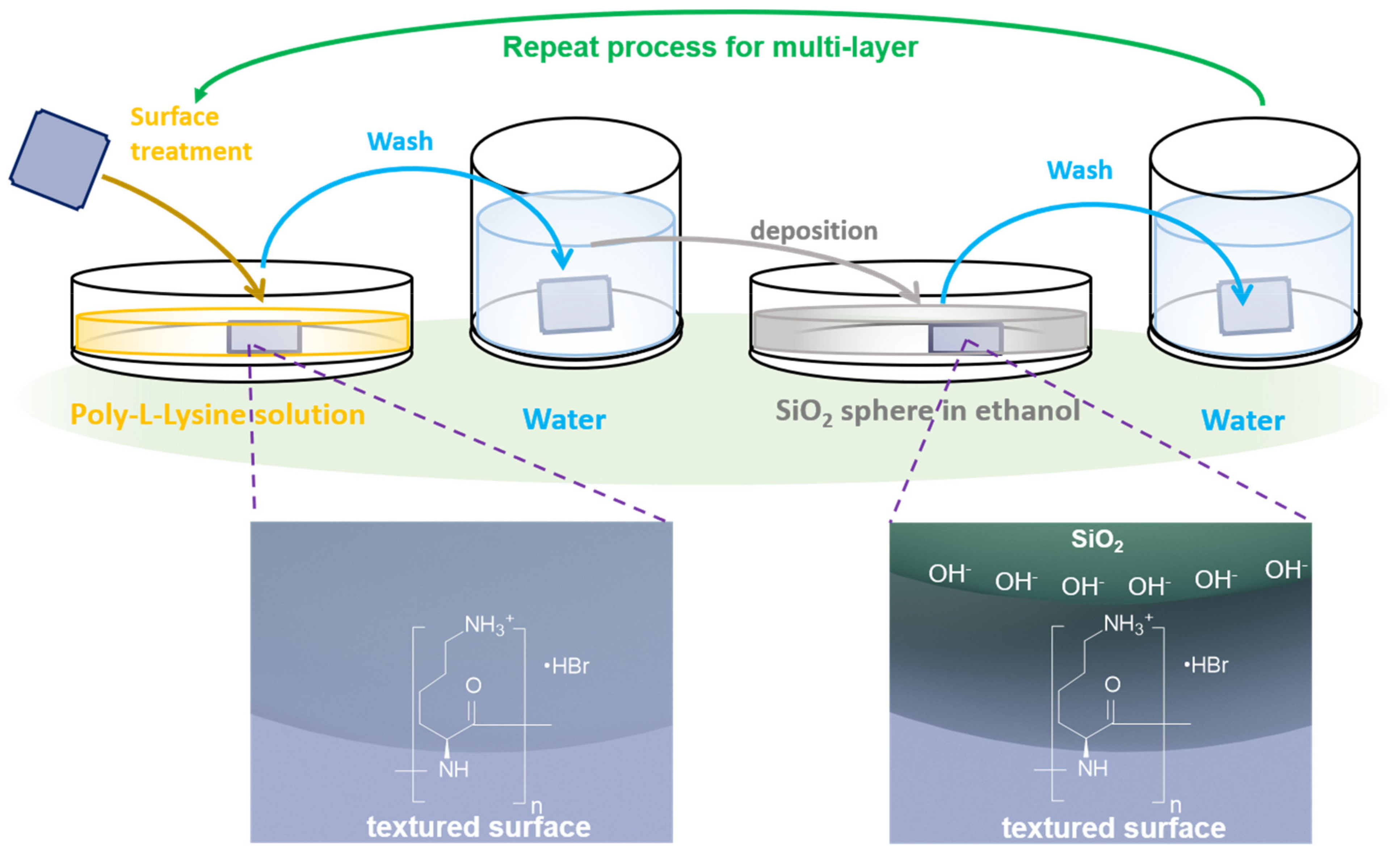
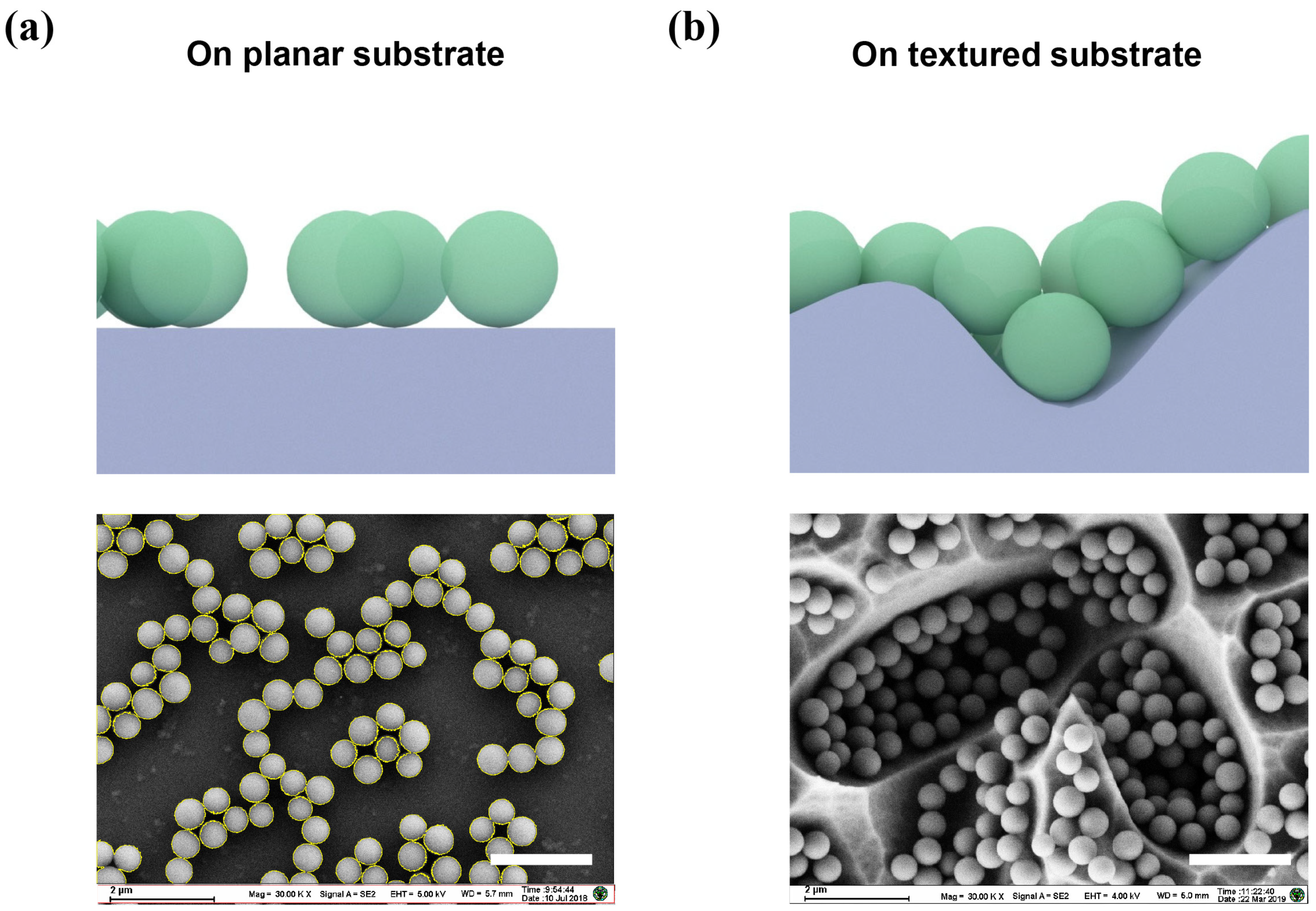

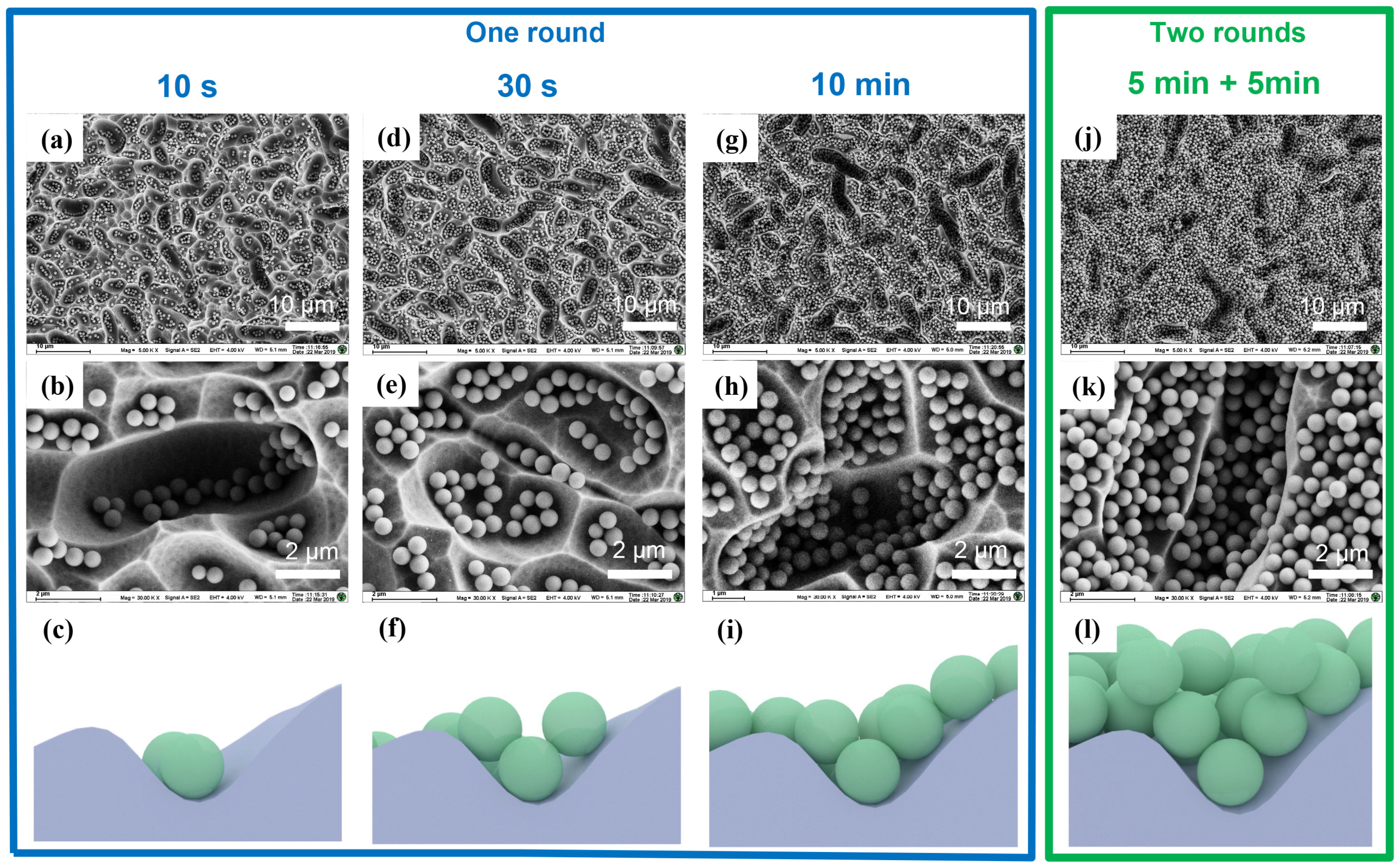

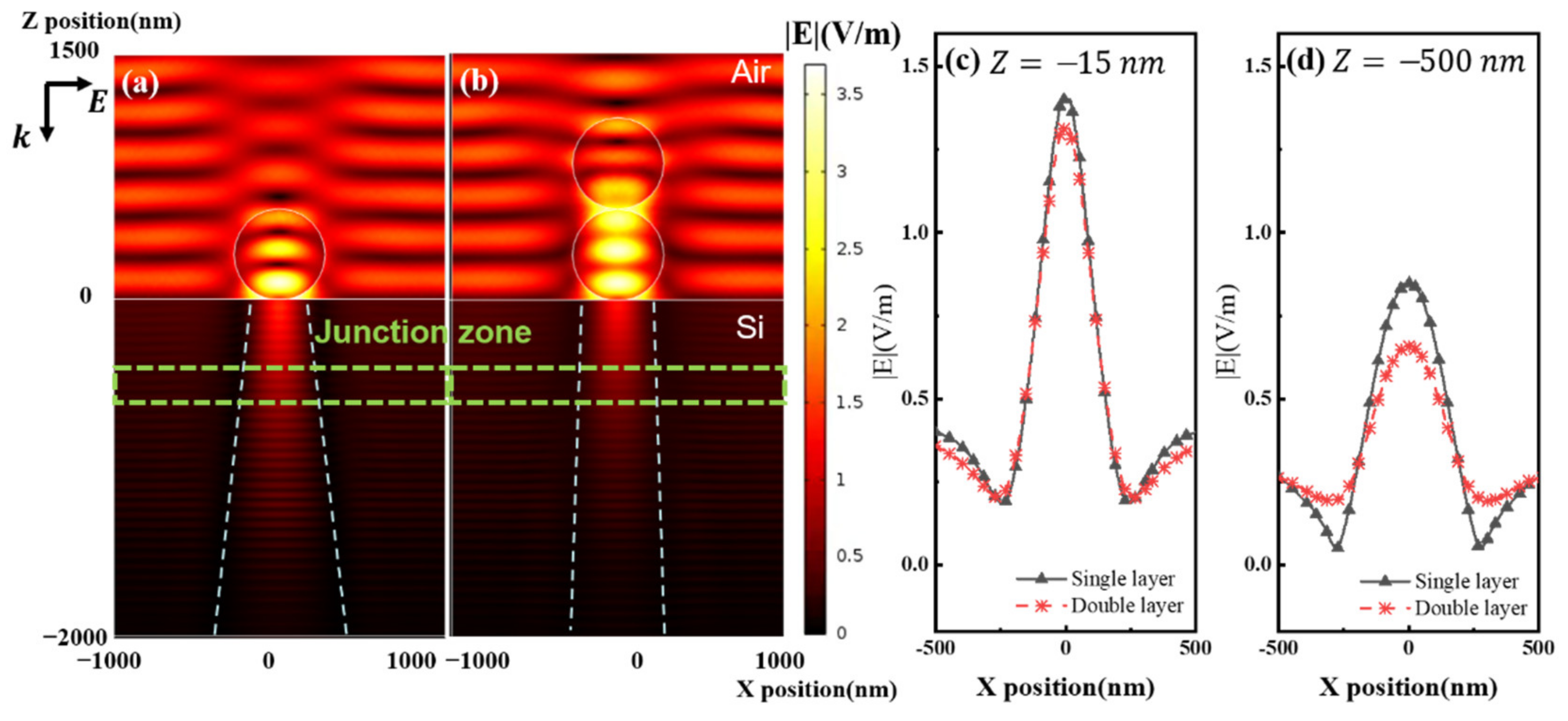

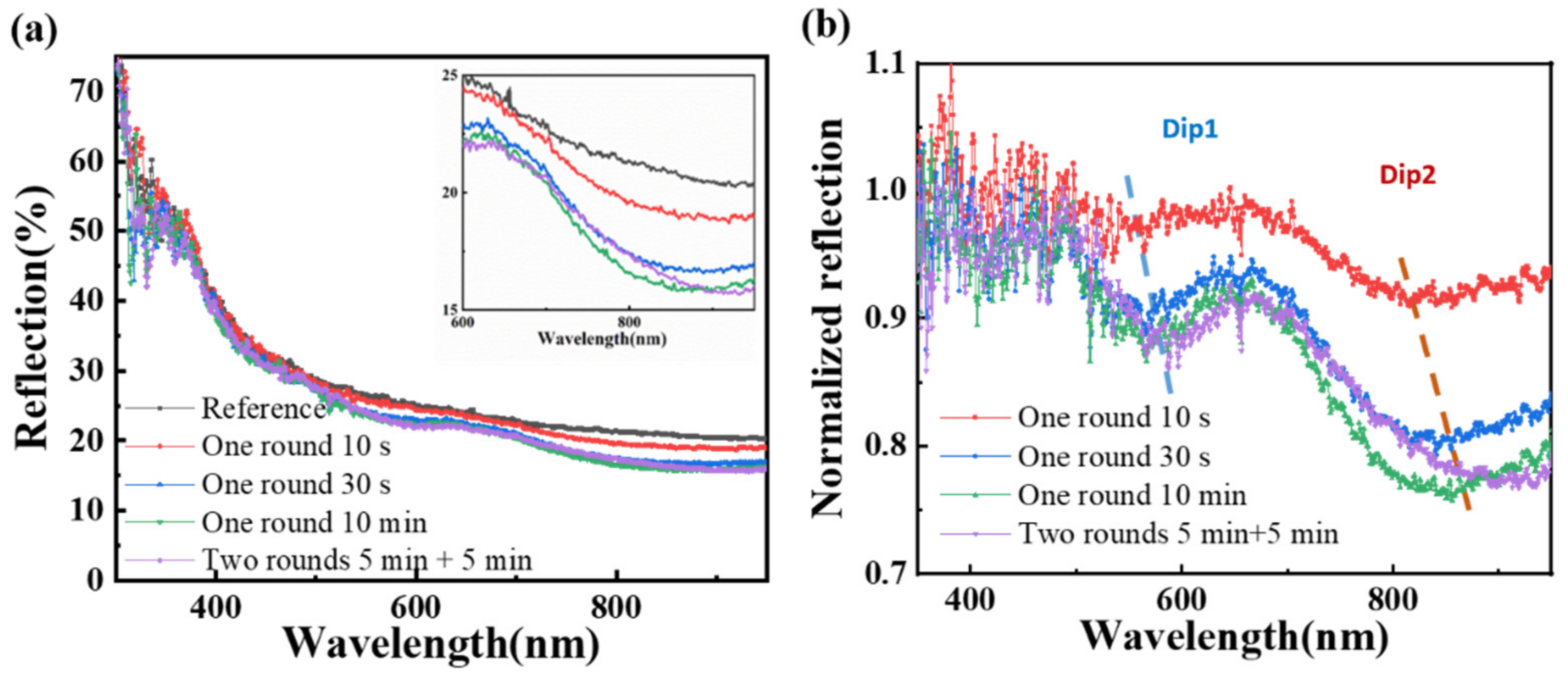

| Description | Voc (V) | Jsc (mA/cm2) | Fill Factor (%) | Efficiency (%) |
|---|---|---|---|---|
| S1 | 0.537 ± 0.001 | 24.98 ± 0.32 | 50.2 ± 0.1 | 6.73 ± 0.10 |
| S1–One round 10 s | 0.538 ± 0.001 | 25.62 ± 0.29 | 50.3 ± 0.2 | 6.93 ± 0.12 |
| Relative enhancement (%) | 0.19 | 2.55 | 0.20 | 2.96 |
| S2 | 0.546 ± 0.001 | 24.93 ± 0.13 | 61.4 ± 0.1 | 8.36 ± 0.04 |
| S2–One round 30 s | 0.550 ± 0.001 | 26.16 ± 0.17 | 62.5 ± 0.1 | 8.99 ± 0.07 |
| Relative enhancement (%) | 0.73 | 4.93 | 1.79 | 7.63 |
| S3 | 0.567 ± 0.001 | 27.06 ± 0.24 | 61.3 ± 0.1 | 9.40 ± 0.10 |
| S3–One round 10 min | 0.569 ± 0.001 | 28.89 ± 0.19 | 62.5 ± 0.1 | 10.28 ± 0.09 |
| Relative enhancement (%) | 0.18 | 6.76 | 1.96 | 9.35 |
| S4 | 0.550 ± 0.001 | 27.13 ± 0.26 | 64.8 ± 0.2 | 9.67 ± 0.07 |
| S4–Two rounds 5 min + 5 min | 0.553 ± 0.001 | 28.42 ± 0.26 | 65.1 ± 0.1 | 10.22 ± 0.10 |
| Relative enhancement (%) | 0.55 | 4.76 | 0.46 | 5.69 |
| Description | Reference | One Round 10 s | One Round 30 s | One Round 10 min | Two Rounds 5 min + 5 min |
|---|---|---|---|---|---|
| BF-average | 57.76 | 45.61 | 46.09 | 43.59 | 45.43 |
| DF-average | 57.47 | 61.7 | 62 | 53.18 | 67.48 |
| BF-std. | 36.67 | 29.91 | 25.92 | 25.69 | 23.22 |
| DF-std. | 73.42 | 63.47 | 51.61 | 48.54 | 45.83 |
Publisher’s Note: MDPI stays neutral with regard to jurisdictional claims in published maps and institutional affiliations. |
© 2021 by the authors. Licensee MDPI, Basel, Switzerland. This article is an open access article distributed under the terms and conditions of the Creative Commons Attribution (CC BY) license (https://creativecommons.org/licenses/by/4.0/).
Share and Cite
Su, D.; Lv, L.; Yang, Y.; Zhou, H.-L.; Iqbal, S.; Zhang, T. Simple Self-Assembly Strategy of Nanospheres on 3D Substrate and Its Application for Enhanced Textured Silicon Solar Cell. Nanomaterials 2021, 11, 2581. https://doi.org/10.3390/nano11102581
Su D, Lv L, Yang Y, Zhou H-L, Iqbal S, Zhang T. Simple Self-Assembly Strategy of Nanospheres on 3D Substrate and Its Application for Enhanced Textured Silicon Solar Cell. Nanomaterials. 2021; 11(10):2581. https://doi.org/10.3390/nano11102581
Chicago/Turabian StyleSu, Dan, Lei Lv, Yi Yang, Huan-Li Zhou, Sami Iqbal, and Tong Zhang. 2021. "Simple Self-Assembly Strategy of Nanospheres on 3D Substrate and Its Application for Enhanced Textured Silicon Solar Cell" Nanomaterials 11, no. 10: 2581. https://doi.org/10.3390/nano11102581
APA StyleSu, D., Lv, L., Yang, Y., Zhou, H.-L., Iqbal, S., & Zhang, T. (2021). Simple Self-Assembly Strategy of Nanospheres on 3D Substrate and Its Application for Enhanced Textured Silicon Solar Cell. Nanomaterials, 11(10), 2581. https://doi.org/10.3390/nano11102581





